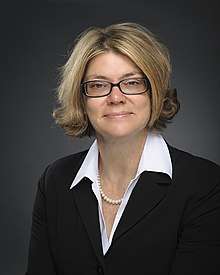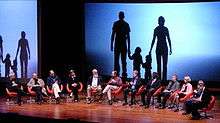Renee Reijo Pera
Renee Reijo Pera is a stem cell biologist and the Vice President of Research and Economic Development at California Polytechnic State University. Prior to this appointment, she held the same title at Montana State University. Reijo Pera's research focuses on human embryo growth and development to describe and better understand unique properties of human embryonic stem cells.
Renee Reijo Pera | |
|---|---|
 | |
| Alma mater | University of Wisconsin–Superior, BS, 1983 Kansas State University, MS, 1987 |
| Known for | Human reproductive biologist |
| Home town | Iron River, Wisconsin |
| Spouse(s) | Fred Pera |
| Scientific career | |
| Fields | Stem Cell Biology |
| Institutions | California Polytechnic State University (current) Montana State University Stanford University University of California, San Francisco Whitehead Institute |
| Influences | David C. Page |
Education and early career
Reijo Pera grew up in Iron River, Wisconsin as the youngest of six children. She initially enrolled in University of Wisconsin–Superior as a business major, but switched her interests during her junior year after taking a class on human genetics for non-majors.[1] She changed her major to biology and received her Bachelor's degree in 1983, becoming the first in her family to finish a four-year degree.[2]
She then attended Kansas State University to work as a research technician, and ultimately received her Master's degree in Entomology.[1] She next attended Cornell University, where she received her Doctorate in biochemistry in 1993, working in the laboratory of Tim Huffaker. There, her research centered on studying mitotic and meiotic mutants in the yeast Saccharomyces cerevisiae.
In 1993, Reijo Pera became a postdoctoral researcher at the Whitehead Institute, which is affiliated with the Massachusetts Institute of Technology. There, she worked in the laboratory of David C. Page, where she worked to map genes linked to male infertility on the Y chromosome, including those that result in a total loss of sperm.[3]
Research career
Career trajectory and leadership
In 1997, Reijo Pera became an Assistant Professor at the University of California, San Francisco and in 2003 became the co-Director of the UCSF Human Development Center after receiving a promotion to Associate Professor. In 2007, she moved her laboratory to Stanford University, where she was a Professor. She later became the director of Stanford's Center for Human Pluripotent Stem Cell Research and Education, as well as the Center for Reproductive and Stem Cell Biology.
In 2014, she became the Vice President of Research and Economic Development at Montana State University, seeking to have a bigger impact on science education.[4] During her tenure, she helped to grow the university's total research expenditures to a record of $131 million and increased the number of funded student projects by over 20 percent.[5] In 2019, she moved again to California Polytechnic State University to serve as the Vice President of Research and Economic Development.
Research interests
Reijo Pera has cited her experience of developing a rare kind of ovarian cancer, called a granulosa cell tumour, early in her career as a motivating factor for her decision to study embryonic development and fertility.[2] The cancer resulted in her own loss of fertility.[6]
In men, her research team and collaborators have investigated mechanisms of male infertility. In a study published in 2000, she found that some infertile men have mutations in the genes required for DNA repair, which in turn may lead to defects in meiotic cell division—also known as meiotic arrest—and inviable sperm.[7][8] Defects in DNA repair mechanisms may result in DNA with a series of harmful mutations, so infertility may be nature's way of preventing offspring who inherit such mutations. This study, done in collaboration with Paul J. Turek, raises concerns around men who have this condition undergoing intracytoplasmic sperm injection, whereby a sperm is directly injected into an egg, because their children may inherit defective DNA-repair machinery, increasing the likelihood of infertility and the risk of cancer.[8]
Her research group has also worked on developing alternative solutions for men experiencing infertility. In 2014, she published a method of deriving immature sperm cells from skin cells with the hope of ultimately making those sperm cells viable.[9][10] Her team extracted skin cells from infertile men and manipulated them to become induced pluripotent stem cells, which can subsequently become virtually any cell in the body—including sperm. The study did stir up some controversy, leading to discussions around misuse of such a technology, though work remains to be done to ultimately produce viable sperm cells from this procedure.[9][11]

Reijo Pera has also worked to develop methods to improve the chances of pregnancy during in vitro fertilization by identifying and selecting the strongest and healthiest embryos for implantation.[12][13] To do so, she essentially devised a method to film the embryo using a microscope as it divides for the first time and then measure the differences between that process across embryos to score which are the most viable.[14] Specifically, they score embryos based on the time it takes to complete the first three cell divisions (i.e. from one cell to 8). Her team was able to predict with 93% accuracy which embryos had the greatest chance of resulting in a successful pregnancy. This work was named a Top 10 Biomedical Breakthrough by Time in 2010.[15]
More broadly, Reijo Pera has also worked to understand how pluripotent embryonic stem cells are ultimately able to mature into their specialized adult forms.[16] She and her collaborators decided to focus their attention on identifying certain developmental milestones that occur in an embryo one week after fertilization, measuring gene expression in individual cells. They identified genes that were derived from the human endogenous retrovirus K, which activate key genes during early development and confer the embryo with immunity against other viruses.[17][18] They later found that the human endogenous retrovirus-H produced key RNA molecules that could either activate or silence genes, acting as "switches" for gene expression.[19] Her team found that these switches could help maintain pluripotency.
Entrepreneurship
Reijo Pera has worked to bring her research from "bench to bedside", founding startups geared towards addressing infertility. In 2015, she co-founded Progyny, a start-up offering plans to large companies that would help their female employees cover the cost of fertility treatments; in 2018, the company was named a "Disruptor 50" by CNBC.[20]
Awards and honors
- Top 10 Biomedical Breakthroughs, Time, 2010[15]
- Honorary Doctorate of Human Letters, University of Wisconsin–Superior, 2009
- Twenty Influential Women Leaders in the US, Newsweek, 2006[1]
- Searle Scholars Program, 1998
References
- EST, Newsweek Staff On 12/17/06 at 7:00 PM (2006-12-17). "Leading the Way". Newsweek. Retrieved 2020-03-27.
- "Stem cell researcher Renee Reijo Pera studies embryonic clock". Quanta Magazine. Retrieved 2020-03-27.
- Reijo, R.; Alagappan, R. K.; Patrizio, P.; Page, D. C. (1996-05-11). "Severe oligozoospermia resulting from deletions of azoospermia factor gene on Y chromosome". Lancet. 347 (9011): 1290–1293. doi:10.1016/s0140-6736(96)90938-1. ISSN 0140-6736. PMID 8622504.
- Writer, GAIL SCHONTZLER, Chronicle Staff. "MSU lands a star as new leader of research". Bozeman Daily Chronicle. Retrieved 2020-03-27.
- "MSU's vice president of research taking on new role at Cal Poly". KBZK. 2019-04-10. Retrieved 2020-03-27.
- Regalado, Antonio. "Synthetic human reproduction could be a whole new way to make babies". MIT Technology Review. Retrieved 2020-03-28.
- Nudell, David; Castillo, Michael; Turek, Paul J.; Pera, Renee Reijo (2000-06-01). "Increased frequency of mutations in DNA from infertile men with meiotic arrest". Human Reproduction. 15 (6): 1289–1294. doi:10.1093/humrep/15.6.1289. ISSN 0268-1161. PMID 10831557.
- "Infertility and inheritance". The Economist. ISSN 0013-0613. Retrieved 2020-03-27.
- "'Provocative' Research Turns Skin Cells Into Sperm". NPR.org. Retrieved 2020-03-28.
- Ramathal, Cyril; Durruthy-Durruthy, Jens; Sukhwani, Meena; Arakaki, Joy E.; Turek, Paul J.; Orwig, Kyle E.; Reijo Pera, Renee A. (May 1, 2014). "Fate of iPSCs Derived from Azoospermic and Fertile Men following Xenotransplantation to Murine Seminiferous Tubules". Cell Reports. 7 (4): 1284–1297. doi:10.1016/j.celrep.2014.03.067. PMC 4283769. PMID 24794432.
- "Science Is Getting Us Closer to the End of Infertility". Wired. ISSN 1059-1028. Retrieved 2020-03-28.
- "In the Race for Life, Which Human Embryos Make It?". KQED. Retrieved 2020-03-28.
- Wong, Connie C.; Loewke, Kevin E.; Bossert, Nancy L.; Behr, Barry; De Jonge, Christopher J.; Baer, Thomas M.; Pera, Renee A. Reijo (2010-10-03). "Non-invasive imaging of human embryos before embryonic genome activation predicts development to the blastocyst stage". Nature Biotechnology. 28 (10): 1115–1121. doi:10.1038/nbt.1686. ISSN 1546-1696. PMID 20890283.
- "Biotechnology: Pictures predict embryos' fate". Nature. 467 (7316): 636. October 2010. Bibcode:2010Natur.467Q.636.. doi:10.1038/467636a. ISSN 1476-4687.
- Park, Alice (2010-10-04). "A New Way to Predict IVF Success: Film the Embryo". Time. ISSN 0040-781X. Retrieved 2020-03-28.
- "The Viruses That Made Us Human". www.pbs.org. Retrieved 2020-03-28.
- Grow, Edward J.; Flynn, Ryan A.; Chavez, Shawn L.; Bayless, Nicholas L.; Wossidlo, Mark; Wesche, Daniel J.; Martin, Lance; Ware, Carol B.; Blish, Catherine A.; Chang, Howard Y.; Reijo Pera, Renee A. (June 11, 2015). "Intrinsic retroviral reactivation in human preimplantation embryos and pluripotent cells". Nature. 522 (7555): 221–225. Bibcode:2015Natur.522..221G. doi:10.1038/nature14308. ISSN 0028-0836. PMC 4503379. PMID 25896322.
- Zimmer, Carl (2015-04-23). "Ancient Viruses, Once Foes, May Now Serve as Friends". The New York Times. ISSN 0362-4331. Retrieved 2020-03-28.
- Durruthy-Durruthy, Jens; Sebastiano, Vittorio; Wossidlo, Mark; Cepeda, Diana; Cui, Jun; Grow, Edward J.; Davila, Jonathan; Mall, Moritz; Wong, Wing H.; Wysocka, Joanna; Au, Kin Fai (January 2016). "The primate-specific noncoding RNA HPAT5 regulates pluripotency during human preimplantation development and nuclear reprogramming". Nature Genetics. 48 (1): 44–52. doi:10.1038/ng.3449. ISSN 1546-1718. PMC 4827613. PMID 26595768.
- staff, CNBC com (2018-05-22). "Progyny 2018 Disruptor 50". www.cnbc.com. Retrieved 2020-03-28.